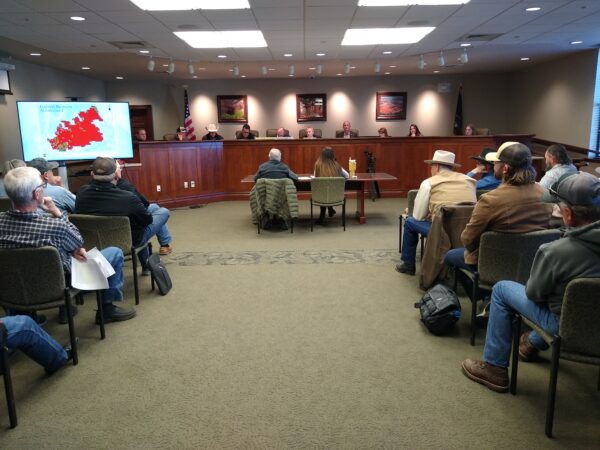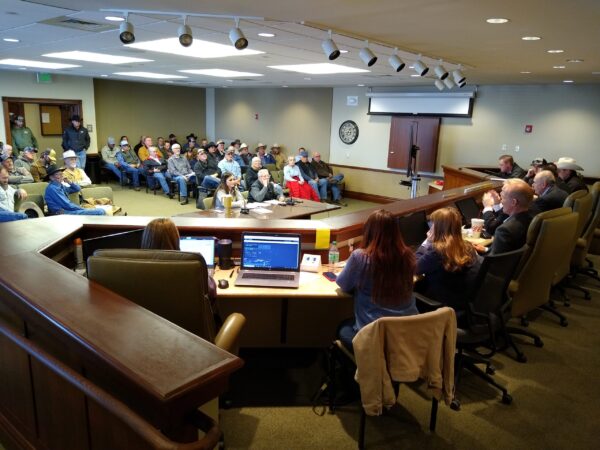On Monday, January 8, Garfield County officials hosted a BLM Coordination Meeting in Panguitch along with Kane County officials. There, the six county commissioners, county staff, and state representatives grilled BLM leadership on the progress of the Grand Staircase-Escalante National Monument planning.
Paria River District Manager Harry Barber and GSENM Monument Manager Adé Nelson were the only two representing the Bureau of Land Management in the meeting.
County and state officials, representing so-called “Cooperating Agencies,” used the meeting as a chance to publicly air their frustration with the BLM’s lack of coordination with them over the last two years. Cooperating agencies, representing the local populace, are under confidentiality agreements with the BLM to not disclose the inner workings of the planning process. Thus, these coordination meetings offer the public an infrequent glimpse into the planning.
In December, 2021, shortly after President Biden restored GSENM to its original boundaries, the director of the BLM mandated Utah’s BLM director to initiate the planning process for a new Resource Management Plan (RMP) for the monument. A final approval deadline was set for March 1, 2024.
Since then, the BLM has failed to meet a number of critical deadlines in the planning process, in what was supposed to be a warp-speed process to be completed before the end of President Biden’s first term.
In Monday’s meeting, county officials focused their questions on the BLM’s unwillingness to provide them a list of protected “objects.” They later discussed the BLM’s attempts to close hundreds of miles of roads, and their near-prohibition of wood gathering and target shooting.
No List of Objects Yet
As the first topic, officials noted that the BLM had failed to provide a list of “objects” which the monument was designated to protect. Previously, the BLM had given local BLM leaders until the end of 2022 to complete a full inventory of the objects. In the December 2022 coordination meeting, Nelson acknowledged that they had missed their deadline, but said she planned on having a list ready to share before the draft Environmental Impact Statement (EIS) was released.
That draft EIS was released last August, which marked the beginning of a 90-day comment period — but still without providing a list of objects to the public or to cooperating agencies.
“Without that list, we really don’t know how to help you with your goals,” David Dodds told the BLM a year ago. “That’s a really important document to us.”
Now two months after the end of the public comment period, Nelson acknowledged that they still have not provided anyone an inventory of the objects designated for protection, and that they do not know when one will finally be made public. The protection of those objects is the primary purpose of the monument.
Garfield Commissioner Leland Pollock objected to the BLM’s unwillingness to provide a list of objects in a timely fashion. He noted that the public’s comments are supposed to be directed to specific objects, but the BLM hasn’t even identified them yet. “Can we honestly consider closing out this process without an inventory list?”
David Dodds reiterated that it was impossible to participate in the planning process without knowing the objects and asked whether it was possible to extend the planning process long enough for a list to be provided and commented on.
Nelson answered that the BLM would still adhere to the two-year planning timeline.
Garfield Commissioner David Tebbs said that local governments, which had to provide their own proposed RMPs ahead of the BLM’s, didn’t even know yet whether those local RMPs were in conflict with objects on the sealed list. “That’s what kind of circus this is.”
It is unclear whether the BLM will release the list of objects before the final RMP is executed, let alone whether the public or local governments will have an opportunity to comment on the list.

Road Closures
County officials also argued with the BLM representatives about the BLM’s “misleading” process of closing hundreds of miles of roads on the monument.
Under Alternative C, which is the BLM’s preferred plan, the BLM will close 520 miles of existing routes, according to Garfield County.
“Those routes are already closed,” Nelson argued.
Taylor Glover, Public Lands Director for Kane County, disputed that. “What you really mean is they’re not designated routes.” Glover’s distinction is important here — whether a route is open or closed is not what the BLM is talking about: the BLM only acknowledges “designated” routes and disregards all other routes, even if they are open.
Glover pointed out that in spite of the BLM’s insistence it was only closing seven miles of roads, Kane County found out that the BLM was only talking about seven miles of designated routes — and that the BLM was sidestepping the issue by not closing undesignated routes directly, but instead by removing entire swaths of the monument from future travel management planning. The move would effectively close all those routes, Glover argued. “That is completely misleading the public.”
Kane County Commissioner Wade Heaton said this tactic of closing roads (by removing them from consideration) was not advertised by the BLM so it wouldn’t draw attention from the public. “This was not done accidently,” he said.
No Coordination
The meeting also discussed the near-prohibition of firewood gathering and target shooting on the monument, with county staff pointing out that the BLM couldn’t even say how either of those activities were damaging objects on the monument. “What’s the matter with harvesting wood?” Dodds asked.
Nelson answered that they did the best they could to allow it where it would be needed, and that we can still hold a future planning process to expand those areas. The comment drew scoffs from the crowd, presumably at the thought of having to repeat this process again later.
“It seems malicious to have all of this [monument area] red [unavailable for wood harvest] without knowing why,” Dodds said.
Attorney for Utah’s Public Lands Policy Coordinating Office, Hayden Ballard, spoke of his experience growing up in Fredonia, Arizona, where men would gather firewood for the widows in their congregations. He pointed out that disallowing that activity under Alternatives C and D had been done without the proper analysis in “environmental justice.”
Pollock said that people outside the region probably don’t realize that most of the area doesn’t have access to natural gas, and rely on wood gathering for heating their homes. He asked why the BLM hadn’t coordinated with locals on this issue.
Indeed, the lack of coordination became the central message of county officials to the BLM, with several citing Section 202(C) of the Federal Land Policy and Management Act, which governs how resource management plans are to be made.
Section 202 of FLPMA emphasizes the multiple use principle of public lands, and requires that the planning process “provide for meaningful public involvement of State and local government officials.” It also requires the Secretary of the Interior to form a plan in a way that considers State and local use plans and to be consistent with them to the maximum extent possible.
State and local officials claim that even if they have been listened to, they’ve been disregarded in the BLM’s RMP planning process. They expressed their concerns that the decision makers in Washington, DC, aren’t heeding any of the input provided by locals and instead are receiving direction only from special interest groups. “You’re supposed to coordinate with us, the locals,” Pollock told the BLM. “Not SUWA up in Salt Lake.”
Dodds had earlier told The Byway that the greatest evidence of the BLM’s disregard for local input was the fact the BLM included almost none of the cooperating agencies’ suggestions in any of the proposed alternatives.
Ballard called the BLM’s listening mere “lip service.”
“You do everything you can to say you’re listening, to check a box,” Garfield Commissioner Jerry Taylor said. “But that’s not enough. These people deserve better than that.”
– The Byway

